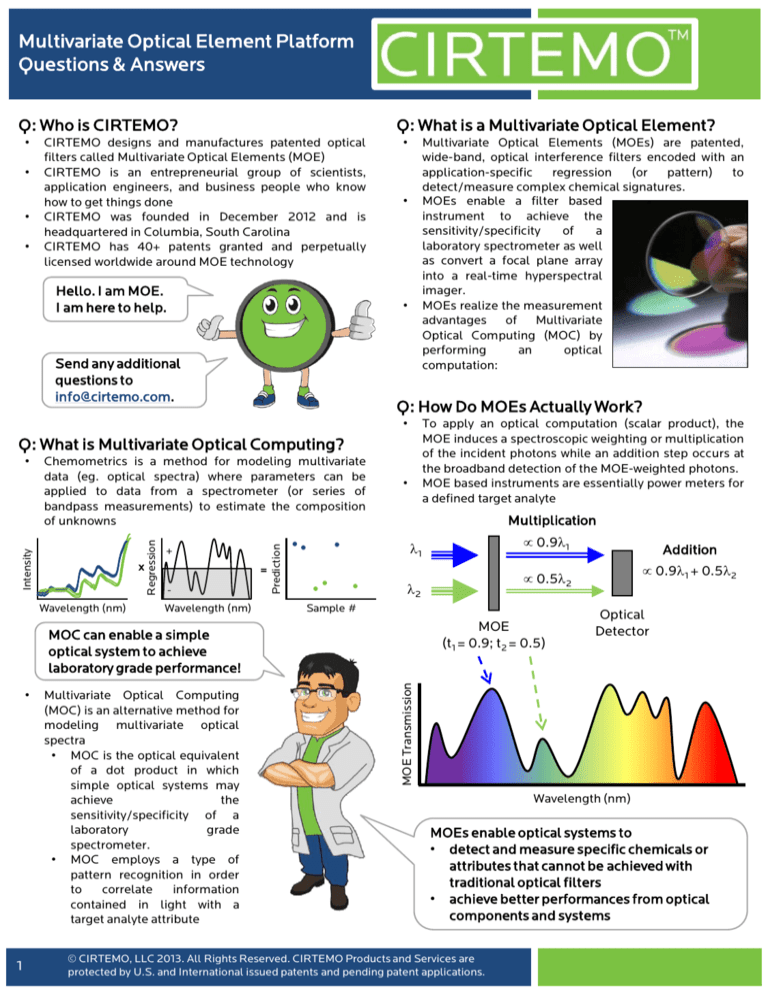
Multivariate Optical Element Platform
Questions & Answers
Q: Who is CIRTEMO?
•
•
•
•
Q: What is a Multivariate Optical Element?
CIRTEMO designs and manufactures patented optical
filters called Multivariate Optical Elements (MOE)
CIRTEMO is an entrepreneurial group of scientists,
application engineers, and business people who know
how to get things done
CIRTEMO was founded in December 2012 and is
headquartered in Columbia, South Carolina
CIRTEMO has 40+ patents granted and perpetually
licensed worldwide around MOE technology
Hello. I am MOE.
I am here to help.
•
Multivariate Optical Elements (MOEs) are patented,
wide-band, optical interference filters encoded with an
application-specific
regression
(or
pattern)
to
detect/measure complex chemical signatures.
MOEs enable a filter based
instrument to achieve the
sensitivity/specificity
of
a
laboratory spectrometer as well
as convert a focal plane array
into a real-time hyperspectral
imager.
MOEs realize the measurement
advantages of Multivariate
Optical Computing (MOC) by
performing
an
optical
computation:
•
•
Send any additional
questions to
info@cirtemo.com.
Q: How Do MOEs Actually Work?
•
To apply an optical computation (scalar product), the
MOE induces a spectroscopic weighting or multiplication
of the incident photons while an addition step occurs at
the broadband detection of the MOE-weighted photons.
MOE based instruments are essentially power meters for
a defined target analyte
Q: What is Multivariate Optical Computing?
Wavelength (nm)
+
=
Wavelength (nm)
•
Multiplication
1
0.91 + 0.52
Sample #
MOE
(t1 = 0.9; t2 = 0.5)
Optical
Detector
MOE Transmission
Multivariate Optical Computing
(MOC) is an alternative method for
modeling multivariate optical
spectra
• MOC is the optical equivalent
of a dot product in which
simple optical systems may
achieve
the
sensitivity/specificity of a
laboratory
grade
spectrometer.
• MOC employs a type of
pattern recognition in order
to
correlate
information
contained in light with a
target analyte attribute
Addition
0.52
2
MOC can enable a simple
optical system to achieve
laboratory grade performance!
•
0.91
1
Prediction
x
Regression
Chemometrics is a method for modeling multivariate
data (eg. optical spectra) where parameters can be
applied to data from a spectrometer (or series of
bandpass measurements) to estimate the composition
of unknowns
Intensity
•
Wavelength (nm)
MOEs enable optical systems to
• detect and measure specific chemicals or
attributes that cannot be achieved with
traditional optical filters
• achieve better performances from optical
components and systems
© CIRTEMO, LLC 2013. All Rights Reserved. CIRTEMO Products and Services are
protected by U.S. and International issued patents and pending patent applications.
Multivariate Optical Element Platform
Questions & Answers
Q: How do MOEs differ from optical band
pass filters?
•
•
•
Multivariate Optical Elements (MOE) are not band pass
(BP) filters
• MOEs possess a higher overall throughput than
individual BP filters yielding a higher analyte
sensitivity baseg
• MOEs sample more spectral wavelengths than
discrete BP filters yielding a higher analyte
specificity
MOEs tend to exhibit fewer layers and lower overall filter
thicknesses than traditional band pass filters.
• Unlike well defined quarter wave optical thickness
(QWOT) deposition recipes used for BP filter
fabrication, there are multiple MOE solutions
possible for any application
• Optimal MOE designs are selected based on a set of
analyte performance criteria in addition to overall
physical thickness and number of layers
MOEs are fabricated via the same methods as traditional
BP filters
•
% Transmission
Thickness
Thickness
High Index Layer
Low Index Layer
•
•
UV
Visible
IR
MOEs may be utilized from the UV to the IR
Traditional chemometric modeling
• identifies and exploits the variance within spectral
(and reference) data to correlate with a
feature/analyte of interest
• most often deconvolves spectroscopic data into a
projection in N-dimensional space (i.e. score)
An MOE is designed through an iterative, non-linear
optimization routine where
• the physical layer thicknesses of an interference
filter are varied in order to achieve a desired
transmission or reflection response
• spectroscopic calibration data as well as
sensor/instrument radiometric data are evaluated in
order to determine a performance metric
Q: How sharp of a spectral feature can an
MOE resolve?
•
Multivariate Optical Elements (MOEs)may be utilized:
• from the ultraviolet (UV) to the infrared (IR)
• in a vast array of spectroscopic modalities like
fluorescence, colorimetric, near infrared (NIR),
MIR and Raman
• for the detection of powders, liquids, slurries and
gases.
Multivariate Optical Elements (MOEs):
• enable a filter photometer to achieve the
sensitivity/specificity of a laboratory spectrometer
• Convert a focal plane array into a real-time
hyperspectral imager
Wherever an optical filter is employed, a MOE may be
able to provide additional value.
MOEs have been previously demonstrated in
applications
ranging
from
process
control
(pharmaceutical, food & beverage, industrial, etc.) to
oceanic monitoring. More recent interest in the MOE
platform spans both the life science and medical device
communities.
Q: How do you design an MOE?
Wavelength (nm)
Q: Where in the Electromagnetic Spectrum
May MOEs be Utilized?
2
•
Multivariate Optical Element
Wavelength (nm)
•
•
% Transmission
Bandpass Filters
Q: What types of systems utilize MOEs?
Although spectral resolution is a typical specification for
defining optical filters, Multivariate Optical Elements
(MOEs) are designed with specifications tied to an
application attribute or feature (i.e. figure of merit).
Q: Can MOEs be designed to minimize or
eliminate non-chemical interferants like
pH or angle of Incidence?
•
Yes. Unlike single bandpass filters, Multivariate Optical
Elements (MOEs) can be designed with environmental
conditions in mind.
Interested in more
information about
the MOE Platform?
Drop me a line at
info@cirtemo.com.
© CIRTEMO, LLC 2013. All Rights Reserved. CIRTEMO Products and Services are
protected by U.S. and International issued patents and pending patent applications.






